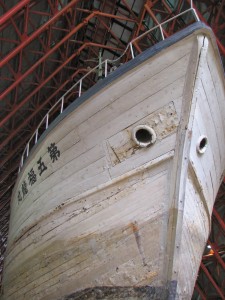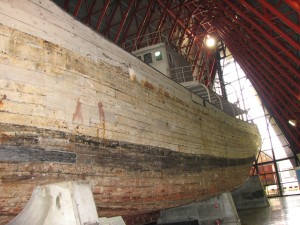Nuclear Fallout – Blast from the Past: Lucky Dragon 60 Years On
WEAPONS OF MASS DESTRUCTION, 3 Mar 2014
Jeff Kingston – The Japan Times
Sixty years ago, on March 1, 1954, a Japanese fishing boat named Lucky Dragon No. 5 was doused by radioactive fallout from a U.S. hydrogen-bomb test, codenamed Castle Bravo, on Bikini Atoll in the Marshall Islands. Although the bomb was over 1,000 times more powerful than the one dropped on Hiroshima in August 1945, Bravo was just one of 67 nuclear tests the U.S. conducted in that part of the North Pacific between 1946-58, rendering some atolls uninhabitable.
On the morning of the test, the wind blew radioactive fallout onto unlucky islanders, American servicemen and that Japanese boat fishing for tuna 160 km east of the blast site, some 32 km outside the exclusion zone. The crew reported that sandy ash fell onto the vessel for a few hours, and soon after they began to suffer nausea. By the time they returned to their home port of Yaizu in Shizuoka Prefecture on March 14, they had serious symptoms of radiation sickness and were hospitalized in Tokyo. The radio operator died six months later with American doctors insisting fallout was not the cause — a finding that Japanese doctors disputed.
The U.S. government’s response was defensive, marked by a level of suspicion and prickliness that only the truly guilty can conjure up. The chairman of the U.S. Atomic Energy Commission apparently told President Dwight Eisenhower, based on no evidence, that the crew may have been Soviet spies trying to gather information. In the end, the U.S. provided trivial compensation to the men — but without any admission of legal responsibility.
And the contaminated tuna? It was sold in the Osaka central market and contaminated fish was consumed. Media reports stoked public anxieties and a fish-eating country stopped eating fish. Fish markets closed amid the hysteria and the government quickly set up radiation-inspection facilities in designated ports to try to reassure spooked consumers — but with little success.
Then, when a Japanese scientist trying to assess the public-health dangers asked an American media contact to request information from the U.S. Atomic Energy Commission, the American’s bureau chief blocked transmission of the letter, assuming it was a publicity stunt designed to embarrass the United States. U.S. doctors who examined the crewmen also seemed unsympathetic — declaring that they were in better condition than expected and would recover within a few weeks.
During the postwar Allied Occupation that ended in 1952, Japan’s media had been forbidden from reporting on nuclear-bomb-related issues, so the Lucky Dragon incident was an opportunity to vent long-suppressed anguish and sparked intensive critical coverage.
The incident, and American efforts to downplay the consequences, infuriated many Japanese. This indignation kindled an anti-nuclear, anti-American movement that gathered steam, culminating in mass demonstrations against the U.S.-Japan Security Treaty in 1960.
Meanwhile, food-safety issues led housewives in Tokyo’s Suginami Ward to establish what became a powerful consumers movement. More famously, the Lucky Dragon incident inspired the sci-fi film “Godzilla,” whose eponymous monster awoken by the bomb tests first strode the nation’s big screens later the same year.
In a recent email interview with Robert Jacobs, an American researcher affiliated with the Hiroshima Peace Institute at Hiroshima City University, he explained: “As I’ve written in my 2010 book ‘The Dragon’s Tail: Americans Face the Atomic Age,’ the Bravo test was how the world really learned the true dangers of radioactive fallout from nuclear detonations. Until that time the U.S. had been able to keep this fairly secret. People knew that survivors in Hiroshima suffered from radiation sickness, but assumed that these were all people close enough to experience the other effects of the bomb (blast and heat).
“Even after the disaster of the Bravo test, the U.S. was able to keep a lid on things for a few weeks, carefully managing reports of contamination of the Rongelapese (people in the Marshall Islands), but when the Lucky Dragon pulled into port they were no longer able to contain the news.
“The main thing the Lucky Dragon told us about radiation was that you could be over 160 km away from the detonation of a nuclear weapon and it could still kill you. What had previously been abstract fears about the genocidal nature of nuclear weapons was suddenly made real, with real information, and with real victims.
“This led to the kind of research that showed that people all over the world were being affected by radiation from nuclear tests (Project Sunshine) and spurred the movement to ban nuclear-weapons testing in the atmosphere. Part of the rollout of the Atoms for Peace discourse the following year was to try to push back against the growing sense that nuclear weapons could actually kill all life on Earth.
“It was this incident that led to the proliferation of radiation-mutated sci-fi monsters (such as Godzilla and the giant ants in “Them!”), all of which were given life and power by nuclear testing, not nuclear warfare.”
Jacobs adds, “Had the Lucky Dragon not made it to port, and had it not done so in a place with a relatively free press, the nuclear powers may have been able to hide the toxic damage of their testing regimes for some more years.”
Luckily it happened back then — because these days it would probably be designated a special secret and buried.
This shameful tale gets worse. The U.S. Congress investigated Marshall Islanders’ compensation claims and made financial settlements. The redress money was then invested in an income-generating fund, but evaporated in one of those Wall Street moments, leaving most islanders high and dry, the majority receiving less than 15 percent of what they were promised.
As usual, too, zapped U.S. veterans were just screwed. Eisenhower never offered an apology to the Japanese victims, nor did he demonstrate contrition about the Lucky Dragon incident, while the testing continued for another four years.
It’s time for Washington to live up to values it trumpets and take the measure of this disgraceful history.
I agreed with the Obama administration’s criticism of Prime Minister Shinzo Abe’s disastrous visit to Yasukuni Shrine at the end of last year, and was impressed by Ambassador Caroline Kennedy’s frank criticism of the Taiji dolphin slaughter. That’s what friends are for. But U.S. credibility in Japan would soar if Washington started taking responsibility and expressing contrition for its own past misdeeds. Kennedy could start by visiting the Lucky Dragon Museum in Tokyo, where the ship is on display, and offering an official government apology for what happened.
Isn’t it time the U.S. started apologizing? Maybe it would find that people everywhere would be readier to hear its criticisms if it would also admit its mistakes.
____________________________
Jeff Kingston is the director of Asian Studies, Temple University Japan.
Go to Original – japantimes.co.jp
DISCLAIMER: The statements, views and opinions expressed in pieces republished here are solely those of the authors and do not necessarily represent those of TMS. In accordance with title 17 U.S.C. section 107, this material is distributed without profit to those who have expressed a prior interest in receiving the included information for research and educational purposes. TMS has no affiliation whatsoever with the originator of this article nor is TMS endorsed or sponsored by the originator. “GO TO ORIGINAL” links are provided as a convenience to our readers and allow for verification of authenticity. However, as originating pages are often updated by their originating host sites, the versions posted may not match the versions our readers view when clicking the “GO TO ORIGINAL” links. This site contains copyrighted material the use of which has not always been specifically authorized by the copyright owner. We are making such material available in our efforts to advance understanding of environmental, political, human rights, economic, democracy, scientific, and social justice issues, etc. We believe this constitutes a ‘fair use’ of any such copyrighted material as provided for in section 107 of the US Copyright Law. In accordance with Title 17 U.S.C. Section 107, the material on this site is distributed without profit to those who have expressed a prior interest in receiving the included information for research and educational purposes. For more information go to: http://www.law.cornell.edu/uscode/17/107.shtml. If you wish to use copyrighted material from this site for purposes of your own that go beyond ‘fair use’, you must obtain permission from the copyright owner.
One Response to “Nuclear Fallout – Blast from the Past: Lucky Dragon 60 Years On”
Read more
Click here to go to the current weekly digest or pick another article:
WEAPONS OF MASS DESTRUCTION:


After the experimental explosion of the hydrogen-bomb in the Bikini Atoll, and after the local authorities made sure of the safety of the radioacitivy, and allowed the residents return to their islands, what happened to the residents? They suffered from the radioactivity.
The same or similar things are happening to the Fukushima area now. The Japanese government claim that the exposure to radioactivity at the rate of 20 mili-sievert per year is safe and encourages the local residents to return their hometowns. Few of the residents return because the they know that the safety level of the exposure to radioactivity is 1 mili-sievert per year or less. This ratio difference is huge: 20 vs. 1.
Who wants to buy agricultural products whose radioacitive level is 20 mili-sievert per year, for instance? Besides, there is no scientific guarantee that 20 mili-sievert of exposure to radioactivity is safe for the local residents to live there from now on, for a long time.
Bikini Atoll and Fukushima. Did we, humans, learn a lesson from the past experience? Some of the fishermen of the Lucky Dragon claim that we should learn the lesson now.